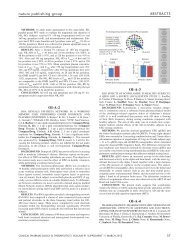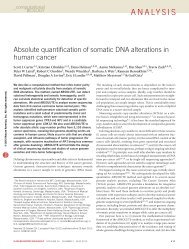open access: Nature Reviews: Key Advances in Medicine
open access: Nature Reviews: Key Advances in Medicine
open access: Nature Reviews: Key Advances in Medicine
You also want an ePaper? Increase the reach of your titles
YUMPU automatically turns print PDFs into web optimized ePapers that Google loves.
<strong>in</strong> CLL. Four cases were analyzed and 46<br />
somatic mutations were identified. 2 Four<br />
genes with recurrent mutations were confirmed<br />
<strong>in</strong> 363 patients with CLL: NOTCH1,<br />
XPO1, MYD88 and KLHL6. Mutations <strong>in</strong><br />
MYD88 and KLHL6 were predom<strong>in</strong>antly<br />
found <strong>in</strong> patients with CLL who had a high<br />
number of somatic hypermutations <strong>in</strong> the<br />
variable region of IGHV, whereas mutations<br />
<strong>in</strong> NOTCH1 and XPO1 were mostly<br />
detected <strong>in</strong> patients who did not have IGHV<br />
mutations. These f<strong>in</strong>d<strong>in</strong>gs <strong>in</strong>dicate a role<br />
for mutations <strong>in</strong> NOTCH1, MYD88 and<br />
XPO1 <strong>in</strong> the cl<strong>in</strong>ical evolution of CLL.<br />
In a similar study on 91 patients with<br />
CLL, Wang et al. 3 performed massively parallel<br />
sequenc<strong>in</strong>g of 88 whole exomes and<br />
genomes. They found n<strong>in</strong>e genes that are<br />
mutated at significant frequencies, <strong>in</strong>clud<strong>in</strong>g<br />
four with established roles (TP53 <strong>in</strong> 15%<br />
of patients, ATM <strong>in</strong> 9%, MYD88 <strong>in</strong> 10%, and<br />
NOTCH1 <strong>in</strong> 4%) and five genes without<br />
established roles (SF3B1, ZMYM3, MAPK1,<br />
FBXW7, and DDX3X). SF3B1, which functions<br />
at the catalytic core of the spliceosome,<br />
was the second most frequently mutated<br />
gene (15% of patients). SF3B1 mutations<br />
occurred primarily <strong>in</strong> tumors with deletions<br />
<strong>in</strong> chromosome 11q, which are associated<br />
with a poor prognosis. The authors also<br />
showed that mutations <strong>in</strong> SF3B1 <strong>in</strong>duced<br />
alterations <strong>in</strong> pre–mRNA splic<strong>in</strong>g.<br />
All three studies have considerable cl<strong>in</strong>ical<br />
implications for CLL. Firstly, the stem<br />
cell orig<strong>in</strong> of CLL offers a plausible explanation<br />
for the fact that conventional chemoimmunotherapies<br />
regularly fail to cure CLL.<br />
This type of therapy may not effectively<br />
eradi cate the HSC pool that regenerates CLL<br />
cells. Secondly, our understand<strong>in</strong>g of the<br />
genetic basis of CLL has improved. These<br />
advances will facilitate the development of<br />
better-targeted therapies for this disease.<br />
In the past 10 years, a remarkable improvement<br />
<strong>in</strong> overall survival was achieved for<br />
several types of B-cell lymphomas. This<br />
improvement was largely a result of the use<br />
of rituximab, an antibody target<strong>in</strong>g CD20.<br />
In follicular lymphoma, several randomized<br />
trials have demonstrated that addition<br />
of rituximab to different chemotherapeutic<br />
regimens can prolong survival; therefore,<br />
rituximab-based chemoimmuno therapy is<br />
the current standard first-l<strong>in</strong>e treatment.<br />
Disease progression usually occurs 3–5 years<br />
after <strong>in</strong>itial therapy and rituximab ma<strong>in</strong>tenance<br />
therapy was previously shown to have<br />
a cl<strong>in</strong>ical benefit <strong>in</strong> patients with relapsed<br />
disease. The PRIMA study 4 evaluated the<br />
benefit of rituximab ma<strong>in</strong>tenance therapy<br />
after first-l<strong>in</strong>e treatment for follicular lymphoma.<br />
In this study, 1,019 patients who<br />
achieved a response after different chemoimmunotherapies<br />
(rituximab plus cyclophosphamide,<br />
v<strong>in</strong>crist<strong>in</strong>e, doxo rubic<strong>in</strong><br />
and prednisone [R-CHOP]; rituximab plus<br />
cyclophosphamide, v<strong>in</strong>crist<strong>in</strong>e and prednisone;<br />
or rituximab plus fludarab<strong>in</strong>e,<br />
cyclo phosphamide and mitoxantrone) were<br />
randomly assigned to receive 2 years of ma<strong>in</strong>tenance<br />
therapy with rituximab (375 mg/m²<br />
every 8 weeks) or no further therapy (observation).<br />
The ma<strong>in</strong>tenance treatment was<br />
well tolerated. Infectious events were more<br />
common <strong>in</strong> the ma<strong>in</strong>tenance arm than the<br />
observation arm, but were mostly mild or<br />
moderate and only a few patients withdrew<br />
from the study because of toxicity. No significant<br />
decrease <strong>in</strong> immunoglobul<strong>in</strong> levels was<br />
observed and patient quality of life was not<br />
affected by the repeated rituximab <strong>in</strong>fusions.<br />
Ma<strong>in</strong>tenance therapy improved the<br />
quality of response and prolonged progression-free<br />
survival and event-free survival.<br />
No effect on overall survival was shown<br />
for rituximab ma<strong>in</strong>tenance therapy, which<br />
might be expla<strong>in</strong>ed by a short follow-up<br />
period and the efficacy of salvage therapies.<br />
However, rituximab should be considered as<br />
ma<strong>in</strong>tenance therapy after first-l<strong>in</strong>e chemoimmunotherapy<br />
<strong>in</strong> follicular lymphoma, as<br />
the duration of response to first-l<strong>in</strong>e therapy<br />
has prognostic value. 5<br />
The outstand<strong>in</strong>g outcome observed <strong>in</strong><br />
patients with Hodgk<strong>in</strong> lymphoma allowed<br />
researchers to consider a reduction <strong>in</strong><br />
treatment <strong>in</strong>tensity to reduce both acute<br />
and long-term adverse events, such as<br />
<strong>in</strong>fertility and secondary neoplasias. The<br />
<strong>Key</strong> advances<br />
■ Genomic analyses of patients with<br />
chronic lymphocytic leukemia identified<br />
mutations <strong>in</strong> genes such as Notch1 and<br />
SF3B1 that have prognostic impact 2,3<br />
■ Rituximab ma<strong>in</strong>tenance therapy after<br />
first-l<strong>in</strong>e treatment with rituximab-based<br />
chemoimmunotherapy significantly<br />
improves the quality of response and<br />
prolongs progression-free survival <strong>in</strong><br />
patients with follicular lymphoma 4<br />
■ In advanced-stage, high-risk Hodgk<strong>in</strong><br />
lymphoma, reduction <strong>in</strong> treatment<br />
<strong>in</strong>tensity has not improved outcome and<br />
further analyses are needed to def<strong>in</strong>e the<br />
optimal treatment <strong>in</strong>tensity 7<br />
■ Patients with diffuse large B-cell<br />
lymphoma, <strong>in</strong> particular, those with a<br />
non-germ<strong>in</strong>al center B-cell-like subtype,<br />
benefit from the addition of bortezomib<br />
to first-l<strong>in</strong>e chemoimmunotherapy 9<br />
CLINICAL ONCOLOGY<br />
HD10 trial of the German Hodgk<strong>in</strong> Study<br />
Group (GHSG) 6 showed that two cycles of<br />
ABVD (doxo rubic<strong>in</strong>, bleomyc<strong>in</strong>, v<strong>in</strong>blast<strong>in</strong>e<br />
and dacarbaz<strong>in</strong>e) therapy followed<br />
by 20 Gy of <strong>in</strong>volved–field radio therapy<br />
was as efficacious as four cycles of ABVD<br />
and 30 Gy of <strong>in</strong>volved-field radiotherapy<br />
<strong>in</strong> patients with stage I or II disease and<br />
favorable risk factors. Reduced treatment<br />
<strong>in</strong>tensity may be considered as the new<br />
standard treatment for early-stage, lowrisk<br />
Hodgk<strong>in</strong> lymphoma. By contrast, the<br />
reduction of treatment <strong>in</strong>tensity is debated<br />
<strong>in</strong> advanced-stage Hodgk<strong>in</strong> lymphoma<br />
(stage II–IV or IIB with extranodal lesions<br />
or mediast<strong>in</strong>al mass).<br />
The results of the HD12 trial by Borchmann<br />
et al. 7 were slightly disappo<strong>in</strong>t<strong>in</strong>g, because<br />
the reduction of the <strong>in</strong>tensity of chemotherapy<br />
from eight cycles of high-dose<br />
BEACOPP (bleomyc<strong>in</strong>, etoposide, doxorubic<strong>in</strong>,<br />
cyclophosphamide, v<strong>in</strong>crist<strong>in</strong>e,<br />
procarbaz<strong>in</strong>e and prednisolone) to four<br />
cycles of high-dose BEACOPP followed<br />
by four cycles of BEACOPP at the basel<strong>in</strong>e<br />
dose did not reduce the severity of toxicity or<br />
treatment-related mortality, but could possibly<br />
reduce efficacy. Thus, the GHSG considers<br />
eight cycles of high-dose BEACOPP<br />
as the standard treatment for advancedstage<br />
Hodgk<strong>in</strong> lymphoma and is evaluat<strong>in</strong>g<br />
other <strong>in</strong>dividualized, PET-controlled dose<br />
reduction strategies <strong>in</strong> ongo<strong>in</strong>g trials.<br />
Viviani et al. 8 compared BEACOPP and<br />
ABVD <strong>in</strong> advanced-stage Hodgk<strong>in</strong> lymphoma.<br />
In this trial, 331 patients received<br />
either four cycles of high-dose BEACOPP<br />
plus four cycles of BEACOPP at basel<strong>in</strong>e<br />
dose or six to eight cycles of ABVD; each<br />
treatment was followed by <strong>in</strong>volved-field<br />
radiotherapy. The estimated 7-year rate of<br />
freedom from first progression was 85% <strong>in</strong><br />
patients treated with BEACOPP and 73%<br />
<strong>in</strong> patients treated with ABVD. However,<br />
all patients with a relapse or less than complete<br />
response after <strong>in</strong>itial therapy were<br />
treated with multiple cycles of ifosfamideconta<strong>in</strong><strong>in</strong>g<br />
chemotherapy followed by<br />
KEY ADVANCES IN MEDICINE JANUARY 2012 | S15<br />
© Eraxion | Dreamstime.com








